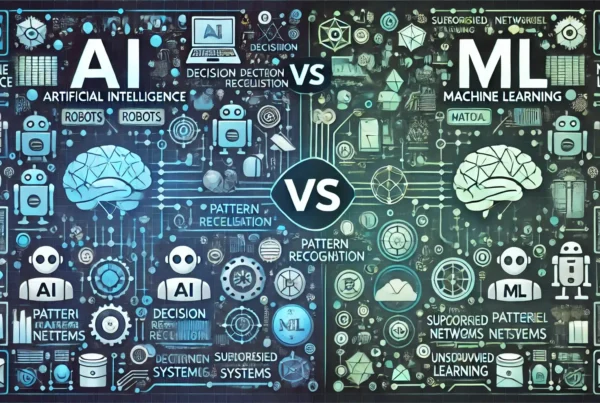Machine learning (ML) is one of the most exciting fields in modern technology. It has become the backbone of innovations like self-driving cars, personalized recommendations, voice recognition, and much more. However, as exciting as it is, starting with machine learning can seem overwhelming, especially if you’re new to the field. The good news is that with the right foundation and understanding of key prerequisites, anyone can start their journey in machine learning.
This article will guide you through the essential knowledge and skills required to begin your machine learning adventure.
1. Understanding the Basics of Machine Learning
Before diving into the technical prerequisites, it’s crucial to understand what machine learning is and why it’s important.
Machine learning is a subset of artificial intelligence (AI) that allows systems to learn and improve from experience without being explicitly programmed. In simpler terms, it enables computers to make decisions based on data rather than being manually coded to perform specific tasks.
There are three main types of machine learning:
- Supervised learning: The model learns from labeled data. For example, identifying whether an email is spam or not based on historical data.
- Unsupervised learning: The model finds patterns in unlabeled data. A popular example is clustering customers based on buying behavior.
- Reinforcement learning: The model learns from actions taken in an environment, receiving rewards or penalties for actions. Think of it as training a computer to play a game.
Having a clear idea of these concepts will help you grasp the importance of the technical skills you’ll need next.
2. Prerequisite 1: Mathematics
Mathematics is at the core of machine learning. You don’t need to be a math genius, but certain areas of math are essential for understanding how machine learning algorithms work.
a. Linear Algebra
Machine learning relies heavily on linear algebra because data is often represented in vectors and matrices. Many algorithms, such as neural networks, involve multiplying matrices to adjust weights and parameters. Key concepts in linear algebra include:
- Vectors and matrices
- Matrix operations (multiplication, transpose)
- Eigenvalues and eigenvectors
b. Probability and Statistics
Machine learning models are built to make predictions, which involves probability and statistics. Probability theory helps in understanding how algorithms like decision trees or Bayesian networks work. Meanwhile, statistics help in understanding data distribution, model evaluation, and hypothesis testing. Important topics to focus on include:
- Conditional probability
- Bayes’ theorem
- Random variables and distributions
- Variance, mean, standard deviation
c. Calculus
In machine learning, especially in algorithms like gradient descent, calculus helps in optimizing models. You should focus on the following topics:
- Derivatives and partial derivatives
- Gradients
- Chain rule
3. Prerequisite 2: Programming Skills
You need strong programming skills to implement machine learning models, process data, and deploy algorithms.
a. Python
Python is the most popular programming language for machine learning. It’s easy to learn and has a rich ecosystem of libraries and tools specifically for machine learning, such as:
- NumPy: For numerical computing and working with arrays.
- Pandas: For data manipulation and analysis.
- Matplotlib/Seaborn: For data visualization.
- Scikit-learn: A powerful library for implementing machine learning algorithms.
While learning Python, focus on understanding how to manipulate data, implement algorithms, and visualize results.
b. Other Programming Languages (Optional)
While Python dominates the ML world, it’s worth noting that R, Java, and Julia are also used in certain applications. If you’re comfortable with these languages or have a background in them, they can also serve as a starting point. However, for beginners, Python remains the best choice due to its simplicity and community support.
4. Prerequisite 3: Data Manipulation and Cleaning
Before you can train a machine learning model, you need to work with data. Raw data is often messy, containing missing values, duplicates, or irrelevant information. Therefore, knowing how to manipulate and clean data is a crucial skill.
a. Data Cleaning
Most of the time spent on machine learning projects is dedicated to cleaning data. This involves:
- Handling missing values: Removing or filling in missing data.
- Dealing with duplicates: Identifying and removing duplicate entries.
- Formatting data: Ensuring all data is in the correct format (e.g., converting strings to numbers).
- Normalizing and scaling data: Many algorithms work better when the data is on a similar scale.
b. Data Exploration
Exploratory Data Analysis (EDA) is another key skill. This involves analyzing and visualizing the data to understand patterns and relationships before applying any models. You’ll use libraries like Pandas and Seaborn to generate descriptive statistics, visualizations, and initial insights from your data.
5. Prerequisite 4: Familiarity with Machine Learning Algorithms
Knowing which algorithms to use for different problems is essential for machine learning. You don’t need to memorize every algorithm, but you should have a strong understanding of the most common ones and when to apply them.
a. Supervised Learning Algorithms
- Linear Regression: Used for predicting a continuous variable.
- Logistic Regression: Used for binary classification problems.
- Decision Trees: A tree-like model used for classification and regression.
- Support Vector Machines (SVM): Used for classification by finding the hyperplane that best divides the classes.
- K-Nearest Neighbors (KNN): A simple algorithm that classifies based on the majority class of nearby points.
b. Unsupervised Learning Algorithms
- K-Means Clustering: Grouping data into clusters based on similarity.
- Hierarchical Clustering: Another clustering method that creates a hierarchy of clusters.
- Principal Component Analysis (PCA): Used for dimensionality reduction, to simplify datasets while retaining important information.
c. Deep Learning (Optional)
For those interested in going beyond basic machine learning, deep learning is a subset of ML that focuses on neural networks. TensorFlow and PyTorch are popular libraries for implementing deep learning models. However, deep learning requires a more advanced understanding of both math and machine learning concepts.
6. Prerequisite 5: Understanding Overfitting and Regularization
Overfitting is one of the most common problems in machine learning. It happens when your model performs well on training data but poorly on unseen data. Learning how to prevent overfitting is crucial for building effective models.
a. Regularization Techniques
Regularization helps prevent overfitting by adding a penalty to overly complex models. Common techniques include:
- L1 and L2 regularization: These penalize large coefficients in linear models.
- Dropout: Used in neural networks to randomly drop units during training, which helps in reducing overfitting.
Understanding these techniques will allow you to fine-tune your models for better generalization.
7. Prerequisite 6: Model Evaluation Metrics
Once you build a model, you need to evaluate how well it performs. You should be familiar with several key evaluation metrics based on the type of problem you’re solving.
a. For Classification Problems
- Accuracy: The ratio of correct predictions to total predictions.
- Precision: The ratio of true positives to predicted positives.
- Recall: The ratio of true positives to actual positives.
- F1 Score: The harmonic mean of precision and recall, balancing both.
b. For Regression Problems
- Mean Absolute Error (MAE): The average of absolute errors between predicted and actual values.
- Mean Squared Error (MSE): The average of the squared errors.
- R-squared: Measures how well the model explains the variance in the data.
Learning when and how to use these metrics will help you choose the best model for your task.
8. Prerequisite 7: Learning to Work with Frameworks and Tools
While learning the theory behind machine learning is important, practical skills with frameworks and tools are equally essential.
a. Scikit-learn
Scikit-learn is the go-to library for most machine learning tasks. It provides a simple interface for a wide variety of algorithms, as well as tools for model evaluation, data preprocessing, and more.
b. TensorFlow and PyTorch (for Deep Learning)
If you plan to dive into deep learning, both TensorFlow and PyTorch are popular frameworks that provide flexibility for building complex neural networks.
c. Jupyter Notebooks
Most data scientists and machine learning engineers use Jupyter Notebooks for prototyping and experimenting with models. It allows you to write and execute code, visualize data, and document your work, all in one place.
9. Prerequisite 8: Developing Problem-Solving Skills
Finally, problem-solving skills are essential. Machine learning is not just about algorithms; it’s about solving real-world problems with data. To develop these skills:
- Start by identifying problems around you that could be solved using machine learning.
- Break down the problem into smaller tasks: data collection, cleaning, feature selection, model selection, and evaluation.
- Experiment with different approaches to find the best solution.
The more problems you solve, the more intuitive machine learning will become.
10. Prerequisite 9: Patience and Perseverance
Machine learning is a vast field, and becoming proficient takes time. It’s normal to encounter obstacles and challenges, but with patience and perseverance, you can overcome them. Start small, build foundational knowledge, and gradually tackle more complex problems.
Conclusion
Machine learning is a rewarding and rapidly growing field, but like any new skill, it requires a solid foundation. By mastering the prerequisites of mathematics, programming, data manipulation, machine learning algorithms, and evaluation techniques, you’ll be well-equipped to start building your own machine learning models. Keep learning, stay curious, and enjoy the journey of discovering the endless possibilities that machine learning can offer.




